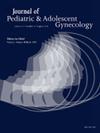48. Gynecology Concerns for Children and Adolescents with Genitourinary Perineal Vascular Anomalies: A Retrospective Analysis
IF 1.7
4区 医学
Q3 OBSTETRICS & GYNECOLOGY
引用次数: 0
Abstract
Background
We investigated the prevalence, management, and outcomes of genitourinary-perineal vascular anomalies (GUP-VAs), focusing on gynecologic concerns in pediatric patients with vulvar anatomy. We compared infantile hemangiomas (IHs) and vascular malformations (VMs) regarding symptom prevalence, functional impairment, treatment approaches, and outcomes. We hypothesized that VMs are associated with more significant gynecologic symptoms, functional impairment, and a higher likelihood of reproductive health counseling. The study aims to further understand gynecologic and developmental needs to improve clinical outcomes and personalized care.
Methods
Following IRB approval, we conducted a retrospective chart review of 119 patients treated for GUP-VAs at Seattle Children's between 1998 and 2024. Patients aged 0-21 years with vulvar anatomy and a GUP vascular anomaly diagnosis were included. Data on demographics, anatomic location, symptoms, functional impairments, treatment modalities, and gynecologic concerns were analyzed. Statistical comparisons between IHs and VMs were conducted using Mann-Whitney U tests for continuous variables and Fisher's exact test for categorical variables, focusing on symptoms, impairments, and treatment outcomes.
Results
Of the 119 patients, 98 (82.4%) had IHs and 21 (17.6%) had VMs. VMs were significantly associated with symptoms of mass (p < 0.001), dyspareunia (p = 0.030), and functional impairments such as pain (p = 0.001) and emotional concerns (p = 0.005). Observation (p = 0.003) and pharmacotherapy (p = 0.004) were more common for IHs, while more invasive treatments like sclerotherapy (p < 0.001) and excision (p = 0.057) were used more frequently for VMs. Post-treatment, patients with VMs showed significant improvements in pain (p = 0.043) and emotional well-being (p = 0.030). Gynecologic issues, such as menstrual irregularities, were prevalent in venolymphatic (100%) and lymphatic malformations (50%), while 50% of patients with lymphatic malformations reported sexual dysfunction. Contraceptive and pregnancy counseling were more common in patients with VMs, particularly those with Klippel-Trenaunay syndrome (66.7%).
Conclusions
VMs in the GUP region are associated with more severe symptoms and greater functional impairments compared to IHs. These findings highlight the physical and emotional impact of VMs and the importance of addressing gynecologic and reproductive health in this population. Treatment outcomes showed significant improvements in pain and emotional well-being, emphasizing the need for early diagnosis and multidisciplinary management to optimize patient outcomes.
48. 儿童和青少年泌尿生殖系统会阴血管异常的妇科关注:回顾性分析
背景:我们调查了泌尿生殖系统-会阴血管异常(GUP-VAs)的患病率、治疗和结局,重点关注外阴解剖的儿科患者的妇科问题。我们比较了婴儿血管瘤(IHs)和血管畸形(vm)在症状患病率、功能损害、治疗方法和结果方面的差异。我们假设vm与更显著的妇科症状、功能障碍和更高的生殖健康咨询可能性相关。该研究旨在进一步了解妇科和发育需求,以改善临床结果和个性化护理。方法:在获得IRB批准后,我们对1998年至2024年间在西雅图儿童医院接受GUP-VAs治疗的119例患者进行了回顾性图表回顾。患者年龄0-21岁,外阴解剖和GUP血管异常诊断。分析了人口统计学、解剖位置、症状、功能障碍、治疗方式和妇科问题的数据。IHs和vm之间的统计比较采用连续变量的Mann-Whitney U检验和分类变量的Fisher精确检验,重点关注症状、损伤和治疗结果。结果119例患者中,IHs 98例(82.4%),vm 21例(17.6%)。vm与肿块症状显著相关(p <;0.001),性交困难(p = 0.030)和功能障碍,如疼痛(p = 0.001)和情绪问题(p = 0.005)。观察治疗(p = 0.003)和药物治疗(p = 0.004)在IHs中更为常见,而硬化治疗等更具侵入性的治疗(p <;0.001)和切除(p = 0.057)更常用于vm。治疗后,vm患者的疼痛(p = 0.043)和情绪幸福感(p = 0.030)均有显著改善。妇科问题,如月经不规则,在静脉淋巴畸形(100%)和淋巴畸形(50%)中普遍存在,而50%的淋巴畸形患者报告性功能障碍。避孕和妊娠咨询在VMs患者中更为常见,尤其是Klippel-Trenaunay综合征(66.7%)。结论与IHs相比,GUP区域的svm与更严重的症状和更大的功能损伤相关。这些发现强调了vm对身体和情感的影响,以及解决这一人群妇科和生殖健康问题的重要性。治疗结果显示疼痛和情绪健康有显著改善,强调需要早期诊断和多学科管理以优化患者预后。
本文章由计算机程序翻译,如有差异,请以英文原文为准。
求助全文
约1分钟内获得全文
求助全文
来源期刊
CiteScore
3.90
自引率
11.10%
发文量
251
审稿时长
57 days
期刊介绍:
Journal of Pediatric and Adolescent Gynecology includes all aspects of clinical and basic science research in pediatric and adolescent gynecology. The Journal draws on expertise from a variety of disciplines including pediatrics, obstetrics and gynecology, reproduction and gynecology, reproductive and pediatric endocrinology, genetics, and molecular biology.
The Journal of Pediatric and Adolescent Gynecology features original studies, review articles, book and literature reviews, letters to the editor, and communications in brief. It is an essential resource for the libraries of OB/GYN specialists, as well as pediatricians and primary care physicians.

 求助内容:
求助内容: 应助结果提醒方式:
应助结果提醒方式:


